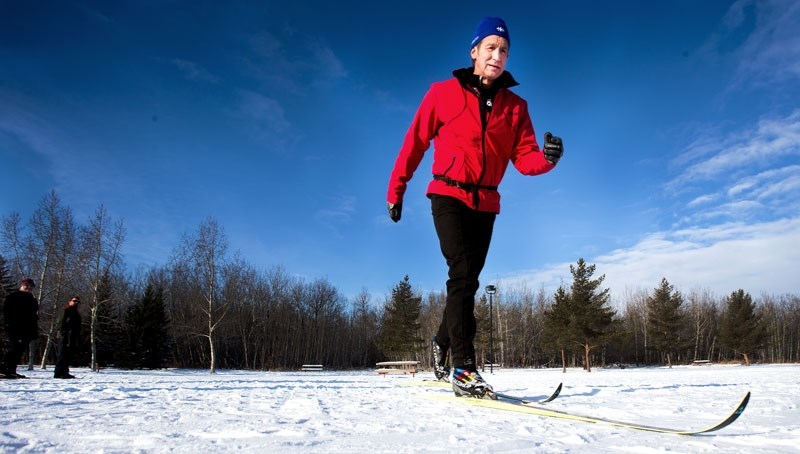Two days later, your body might still be sore. Mind you, after having a mostly sedentary winter and a too-gluttonous holiday season, that shouldn’t be surprising.
But, as with anything else, it will get easier as you go on. That’s what the instructors at a ski clinic hosted by the St. Albert Nordic Ski Club tell me, anyway.
“Once you’ve got the hang of it, it’s very easy and it’s just good for your body,” said Bill Thompson, who led the clinic. “It uses your arms, your legs and your torso. It’s non-impact.”
Non-impact? Maybe if you manage to stay vertical the whole time. If it’s been two decades since you’ve been on a pair of cross-country skis, you might find yourself hitting the snow once or twice in the course of a lesson.
About 20 people, ranging in age from young adults to seniors, took in a free clinic Saturday morning at the Kingswood Day Area in St. Albert, where the club maintains a network of groomed trails stretching from near the St. Albert Botanic Park all the way through to the lower and upper Riverlot 56 areas.
Thompson said volunteers do all the work, and the club focuses mainly on helping recreational users rather than competitive skiers.
“The fun part of instruction for me is helping people do it better, and helping them grow into the sport,” he said. “They enjoy it more because they ski more efficiently. That’s the key word, efficiency.”
But skiing efficiently isn’t exactly as easy as it looks. The diagonal stride, which is the typical cross-country ski stride most people would associate with the sport, uses a combination of muscles from your feet all the way through to your hands. It’s definitely a full-body workout.
Although it does use your full body it is actually fairly low impact, which is why the sport is popular with people of all ages. Thompson said many people with hip or knee replacements can just as easily hit the trails as the younger, more athletic crowd.
“That isn’t an impediment, because it isn’t an impact sport,” he said. “I know one of the instructors in the city who had a hip replacement.”
For many of the beginners who took part in the clinic, it was quite a workout even without having replaced joints to worry about.
Shannon Fitzsimmons said it’s been 30 years since she was on a pair of skis, and it’s a bit tougher without the boundless energy kids manage to come up with.
She decided to get back into it because she simply wanted to have another way to get outside and enjoy the winter.
“It’s something that’s readily accessible, and it’s close by,” she said. “And it’s really not that expensive.”
Max Foster echoed the desire to just get out and enjoy the winter, emphasizing this year he’s got a bit of extra Christmas indulgence to work off as well.
“I love being outside in the summer, and in the winter I’ve always just huddled up and watched Netflix or whatever,” he said. “I thought I would come out and enjoy this.”
He said that he found the most difficult part was keeping himself upright while on the skis – it takes a bit of getting used to.
“I’d feel like I was getting it, then everything would start going haywire. It’s mostly the balance,” Foster said. “And my feet hurt a lot from keeping that balance, when you’re constantly flexing them.”
Miro Sourial said he has been looking for ways to get out and keep active in the winter since moving from Egypt a few years ago, and thinks he has found it in cross-country skiing.
“This whole snow and cold-weather thing is new for me,” he said, adding he tried downhill skiing last year. “I’m guessing it’s a little bit cheaper to just go cross-country instead of downhill.”
He’s probably right. After an initial investment of $200 to $300 for a beginner set of gear, there are no lift-ticket expenses or long car trips to the mountains required to be able to take advantage of the winter weather. And it seems like quite a few people are starting to get more interested in the sport.
Alexandra Rutherford, the club’s adult program director, said demand has been steadily increasing in her 20 years with the club.
“I feel like over the years it’s just been growing and growing, which is just awesome to see,” she said. “I think people are looking to just be more active nowadays. They don’t want to just go to the gym and run on the elliptical (trainer), because that’s just boring; they want to do something a bit more interesting.”
The club offers several sets of adult lessons throughout the season, twice per week. With a capacity of 20 skiers, however, space fills up fast so they’re hoping to be able to offer two sets of lessons concurrently next year.
Rutherford said it’s not just the adult programs that are popular. Childrens’ programs are also picking up some steam because cross-country skiing is relatively accessible.
“In terms of other kids sports, it’s probably the cheapest sport you can do,” she said. “And let’s be honest, cross-country skiers are probably the fittest people you’re going to meet.”
She said anyone who is interested should look into the club’s website at www.stalbertnordic.com, and get in touch if they want any more information.
“It would be really nice to get more people who love skiing out on those trails.”




